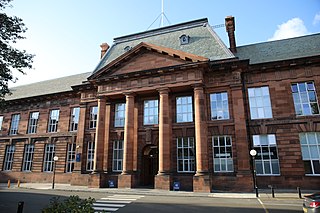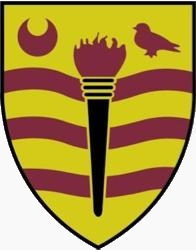

The Bridewell was a prison in Edinburgh, Scotland, built by Robert Adam in 1791. [1]
The remains of the prison can still be seen built into the bottom part of the Scottish Government building on Regent Road. [2]


The Bridewell was a prison in Edinburgh, Scotland, built by Robert Adam in 1791. [1]
The remains of the prison can still be seen built into the bottom part of the Scottish Government building on Regent Road. [2]

Selkirkshire or the County of Selkirk is a historic county and registration county of Scotland. It borders Peeblesshire to the west, Midlothian to the north, Roxburghshire to the east, and Dumfriesshire to the south. It derives its name from its county town, the Royal burgh of Selkirk.
Burray is one of the Orkney Islands in Scotland. It lies to the east of Scapa Flow and is one of a chain of islands linked by the Churchill Barriers.

Bridewell Palace in London was built as a residence of King Henry VIII and was one of his homes early in his reign for eight years. Given to the City of London Corporation by his son King Edward VI for use as an orphanage and place of correction for wayward women, Bridewell later became the first prison/poorhouse to have an appointed doctor. It was built on the banks of the Fleet River in the City of London between Fleet Street and the River Thames in an area today known as Bridewell Place, off New Bridge Street. By 1556 part of it had become a jail known as Bridewell Prison. It was reinvented with lodgings and was closed in 1855 and the buildings demolished in 1863–1864.

Edinburgh College of Art (ECA) is one of eleven schools in the College of Arts, Humanities and Social Sciences at the University of Edinburgh. Tracing its history back to 1760, it provides higher education in art and design, architecture, history of art, and music disciplines for over three thousand students and is at the forefront of research and research-led teaching in the creative arts, humanities, and creative technologies. ECA comprises five subject areas: School of Art, Reid School of Music, School of Design, School of History of Art, and Edinburgh School of Architecture & Landscape Architecture (ESALA). ECA is mainly located in the Old Town of Edinburgh, overlooking the Grassmarket; the Lauriston Place campus is located in the University of Edinburgh's Central Area Campus, not far from George Square.

New College is a historic building at the University of Edinburgh which houses the university's School of Divinity. It is one of the largest and most renowned centres for studies in Theology and Religious Studies in the United Kingdom. Students in M.A., M.Th. and Ph.D. degree programmes come from over 30 countries, and are taught by almost 40 full-time members of the academic staff. New College is situated on The Mound in the north of Edinburgh's Old Town.

Charlotte Square is a garden square in Edinburgh, Scotland, part of the New Town, designated a UNESCO World Heritage Site. The square is located at the west end of George Street and was intended to mirror St. Andrew Square in the east. The gardens, one of the collection of New Town Gardens, are private and not publicly accessible.

Old College is a late 18th-century building of the University of Edinburgh, Scotland. It is located on South Bridge, and presently houses parts of the University's administration, the University of Edinburgh School of Law, and the Talbot Rice Gallery. Originally called the "New College", it was designed by Robert Adam to replace a number of older buildings.

The Dugald Stewart Monument is a memorial to the Scottish philosopher Dugald Stewart (1753–1828). It is situated on Calton Hill overlooking the city of Edinburgh and was designed by Scottish architect William Henry Playfair.

Chambers Street is a street in Edinburgh, Scotland, in the southern extremity of the Old Town. The street is named after William Chambers of Glenormiston, the Lord Provost of Edinburgh who was the main proponent of the Edinburgh Improvement Act (1867) which led to its creation in 1870. A narrow lane named North College Street and three residential squares built in the 18th century—Adam Square, Argyle Square and Brown Square—disappeared in the process. The street is dominated by University and museum buildings. It also hosts a variety of restaurants and venues.

John Paterson was a Scottish architect who trained with Robert Adam (1728–1792) whom he assisted with his work on Edinburgh University Old College and Seton House Castle.

Jedburgh Castle was a castle at Jedburgh in Scotland. It was fought over during the Wars of Scottish Independence, and was demolished by the Scots commanded by Sir James Douglas of Balvenie in 1409. The site of the original castle was used to build the reform prison based on John Howard system, the construction of which started in 1820.

Drummond Community High School (DCHS) is a non-denominational secondary school built originally in 1925 by John Alexander Carfrae which serves the area of north east Edinburgh. Drummond Community High School is on Bellevue Place and was originally known as Bellevue Junior Secondary School. The catchment area serves an area to the east of the city including the southern areas of Leith, Hillside, Abbeyhill, Broughton and Bellevue. In addition to the school roll of 352, the school provides places for over 400 adult day learners and approximately 400 adult learners.

The Queen Mary Harp or Lude Harp, is a Scottish clarsach currently displayed in the National Museum of Scotland. It is believed to date back to the 15th century, and to have originated in Argyll, in South West Scotland. It is one of the three oldest surviving Gaelic harps, the others being the Lamont Harp and the Trinity College Harp.

Greyfriars Kirkyard is the graveyard surrounding Greyfriars Kirk in Edinburgh, Scotland. It is located at the southern edge of the Old Town, adjacent to George Heriot's School. Burials have been taking place since the late 16th century, and a number of notable Edinburgh residents are interred at Greyfriars. The Kirkyard is operated by City of Edinburgh Council in liaison with a charitable trust, which is linked to but separate from the church. The Kirkyard and its monuments are protected as a category A listed building.

Governor's House is a building situated on the southernmost spur of Calton Hill, beside the south-east corner of Old Calton Burial Ground, in Edinburgh, Scotland. It looks out over Waverley Station, the Canongate and Holyrood Park to the south.

Seton Castle is an 18th-century Georgian castle in East Lothian, Scotland. The castle was Robert Adam's final project in Scotland.

George Street is the central thoroughfare of the First New Town of Edinburgh, planned in the 18th century by James Craig.

Thomas Stuart Burnett ARSA was a Scottish sculptor in the 19th century.

Peter Slater RA (1809-1860) was a 19th-century Scottish sculptor and portrait artist. His name sometimes appears as J. P. Slater.

Portobello Swim Centre is a multi-facility leisure venue in Portobello, Edinburgh. Built by Edinburgh City Architect Robert Morham in 1898, it comprises swimming pools, a gym and fitness studio, and Edinburgh's only authentic and publicly available turkish bath, one of three remaining in Scotland. The salt water baths were completed in 1901.
Coordinates: 55°57′11″N3°10′59″W / 55.9531°N 3.1831°W